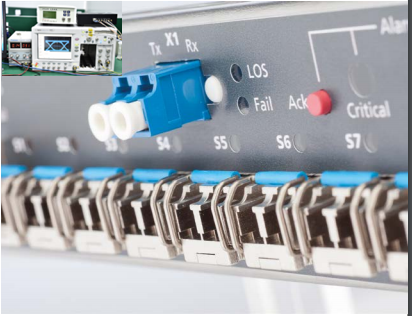The basic test parameters of XFP transceiver
2017-08-29
The finished product of an XFP transceiver, seemingly simple. In fact, the production of a product needs multi-channel detection. There are some parameters are very important in the test. Only these parameters meet the relevant standards can make the optical module best performance. Do you know which test parameters? Now let's learn about it!

1. Output power
Output power refers to the light intensity of the transmitting end, unit is dBm, is the important parameter that affects the transmission distance.
2. Receiving sensitivity
Receiving sensitivity refers to the light intensity that can be detected, unit is dBm. Generally, the higher rate, the worse receiving sensitivity. That is, the larger the minimum receiving optical power, the higher the requirement of the optical module receiving terminal device.
3. Bias current
In order to make the laser LD high speed switch work normally. It must be added to the DC bias current IBIAS which is slightly larger than the threshold current ITH, directly expressed by BIAS. Accelerator assembly aging if BIAS is too large, laser can’t work properly if BIAS is too small.
4. Extinction ratio
The size ratio of optical power when signal logic is 1 and 0, unit is dB. Extinction ratio is inversely proportional to optical power, the extinction ratio will be small when the optical power is large.
5. Saturated optical power
At a certain transmission rate, the maximum input optical power when maintain a certain bit error rate. It will lead to error generation when the received optical power is greater than the saturated optical power. So error phenomenon will appear if the large output power module without attenuation loopback test.
6. Working temperature
Commercial: 0~70℃
Industrial: -40~85℃
Doing business is not simply selling products, but also show our professional services and product technical knowledge to customers. These knowledge is something that some salespeople lack. If you don’t know the test knowledge, how can customers rest assured that the order to you? To become a best sales, we have to learn from the basic knowledge.
XFP module,XFP transceiver,bidi sfp,SFP+ module,SFP+ transceiver Which is good? First choice Fiberland!Thanks for your concern, to learn more about Fiberland, please enter Fiberland website: http://www.fiberlandtec.com/

1. Output power
Output power refers to the light intensity of the transmitting end, unit is dBm, is the important parameter that affects the transmission distance.
2. Receiving sensitivity
Receiving sensitivity refers to the light intensity that can be detected, unit is dBm. Generally, the higher rate, the worse receiving sensitivity. That is, the larger the minimum receiving optical power, the higher the requirement of the optical module receiving terminal device.
3. Bias current
In order to make the laser LD high speed switch work normally. It must be added to the DC bias current IBIAS which is slightly larger than the threshold current ITH, directly expressed by BIAS. Accelerator assembly aging if BIAS is too large, laser can’t work properly if BIAS is too small.
4. Extinction ratio
The size ratio of optical power when signal logic is 1 and 0, unit is dB. Extinction ratio is inversely proportional to optical power, the extinction ratio will be small when the optical power is large.
5. Saturated optical power
At a certain transmission rate, the maximum input optical power when maintain a certain bit error rate. It will lead to error generation when the received optical power is greater than the saturated optical power. So error phenomenon will appear if the large output power module without attenuation loopback test.
6. Working temperature
Commercial: 0~70℃
Industrial: -40~85℃
Doing business is not simply selling products, but also show our professional services and product technical knowledge to customers. These knowledge is something that some salespeople lack. If you don’t know the test knowledge, how can customers rest assured that the order to you? To become a best sales, we have to learn from the basic knowledge.
XFP module,XFP transceiver,bidi sfp,SFP+ module,SFP+ transceiver Which is good? First choice Fiberland!Thanks for your concern, to learn more about Fiberland, please enter Fiberland website: http://www.fiberlandtec.com/
RECENT BLOG POST
-
012019-10With the continuous development of 5G communication technology, 100G modules are gradually becoming popular. We know that there are many kinds of packages for 100G optical modules. From 2000 to now, the optical module package types have been rapidly developed. Its main package types are: GBIC, SFP, XENPAK, SNAP12, X2, XFP, SFP+, QSFP/QSFP+, CFP, CXP. In the fast-developing network era, some 100G optical modules avoid the risk of being eliminated, and upgraded and revised with the wave of the Internet, such as 100G CFP optical modules.
-
012019-101. What is the CWDM SFP? The CWDM optical module is an optical module using CWDM technology to implement the connection between the existing network device and the CWDM multiplexer/demultiplexer. When used with a CWDM multiplexer/demultiplexer, CWDM optical modules can increase network capacity by transmitting multiple data channels with separate optical wavelengths (1270 nm to 1610 nm) on the same single fiber.
-
012019-10AOC is the abbreviation of Active Optical Cables, which is called Active Optical Cables in Chinese. AOC active optical is to encapsulate two optical modules and cable together. Because the medium of transmission in the middle is optical cable, AOC optical module, which contains laser devices, has a higher price for DAC. However, its optical aperture is not exposed, it has high reliability, and its working distance can be customized for a long distance of less than 100 meters.
-
012019-10Dense Wavelength Division Multiplexing (DWDM) technology is capable of transmitting data in an optical fiber using bit wavelength parallel transmission or string line transmission using the wavelength of the laser.It is widely used in different fields of communication networks, including long-distance backbone networks, metropolitan area networks (MANs), residential access networks, and local area networks (LANs).The DWDM optical module is the optical module that uses this technology, so the DWDM optical module has high bandwidth and long-distance transmission characteristics.












